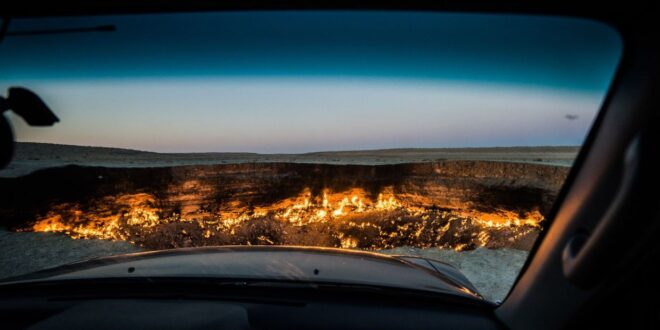NEW YORK: Roughly half a century ago, geologists exploring for hydrocarbons accidentally shattered the roof of a huge underground gas deposit opening a crater 60m wide.
Rather than let the potent methane fumes leak uncontrollably, engineers eventually lit the gas on fire, presumably on the theory that it would quickly burn off. It didn’t and the site is believed to have burned continuously ever since.
The Darvaza Crater, nicknamed the Gates of Hell, for years was promoted as a tourist attraction in the central Asia country of Turkmenistan and has even been recognised by Guinness World Records as the “longest burning methane crater.”
But global concern over the climate impact of methane and carbon dioxide emissions has intensified and in 2022 then-President Gurbanguly Berdymukhamedov announced a plan to close the site.
In an effort to halt the release, the government proposed drilling a well to extract gas from the reservoir feeding the crater so the fuel could be transported to market, where it’s likely to be burned more efficiently to produce power or heat.
Satellite data now shows that plan could be working. The amount of gas burned at the site has fallen roughly 50% since August, according to an analysis by Mark Davis, chief executive officer of Capterio Ltd, which uses satellites to track flaring globally and works with oil and gas producers and governments to cut emissions by optimising operations.
Davis estimates one million standard cubic feet a day of gas is currently being combusted at the site.
Turkmenistan’s Foreign Affairs Ministry didn’t respond to an email seeking comment.
“Whilst the scale of the emissions reduction is modest on the scale of the potential opportunity in Turkmenistan, the success of the intervention is important symbolically,” Davis said.
“Darvaza has been unresolved for decades and the fact that real progress has been made should inspire confidence that Turkmenistan is truly committed to delivering on its climate commitments.”
Methane is the primary component of natural gas and has more than 80 times the warming power of carbon dioxide during its first 20 years in the atmosphere.
Halting releases of the potent greenhouse gas from coal, oil and gas operations are widely agreed to be one of the fastest, cheapest ways to lower global temperatures.
Methane sometimes leaks accidentally but can also be released into the air deliberately or burned off if there’s insufficient infrastructure to get the fuel to market – a practice that remains common in other countries including the United States. While much of the gas emitted from the Darvaza Crater is combusted into CO2, it likely still emits some methane.Turkmenistan sits atop of the world’s fourth-largest natural gas reserves and International Energy Agency (IEA) data shows the nation spews more methane per unit of oil and gas output than any other major supplier.
Any progress towards curbing the potent greenhouse gas that leaks from the sparsely populated nation’s oil and gas infrastructure would be a significant climate victory.
And yet much more work needs to be done. Global methane emissions from fossil fuels held near a record high last year, the IEA said earlier this year in its annual Methane Tracker report.
In December, Bloomberg Green reported foreign petroleum engineers were in Turkmenistan laying the groundwork for a plan to curb the nation’s giant methane emissions with potential help from the United States. — Bloomberg
 BeritaKini.biz Berita Viral Terkini di Malaysia
BeritaKini.biz Berita Viral Terkini di Malaysia





